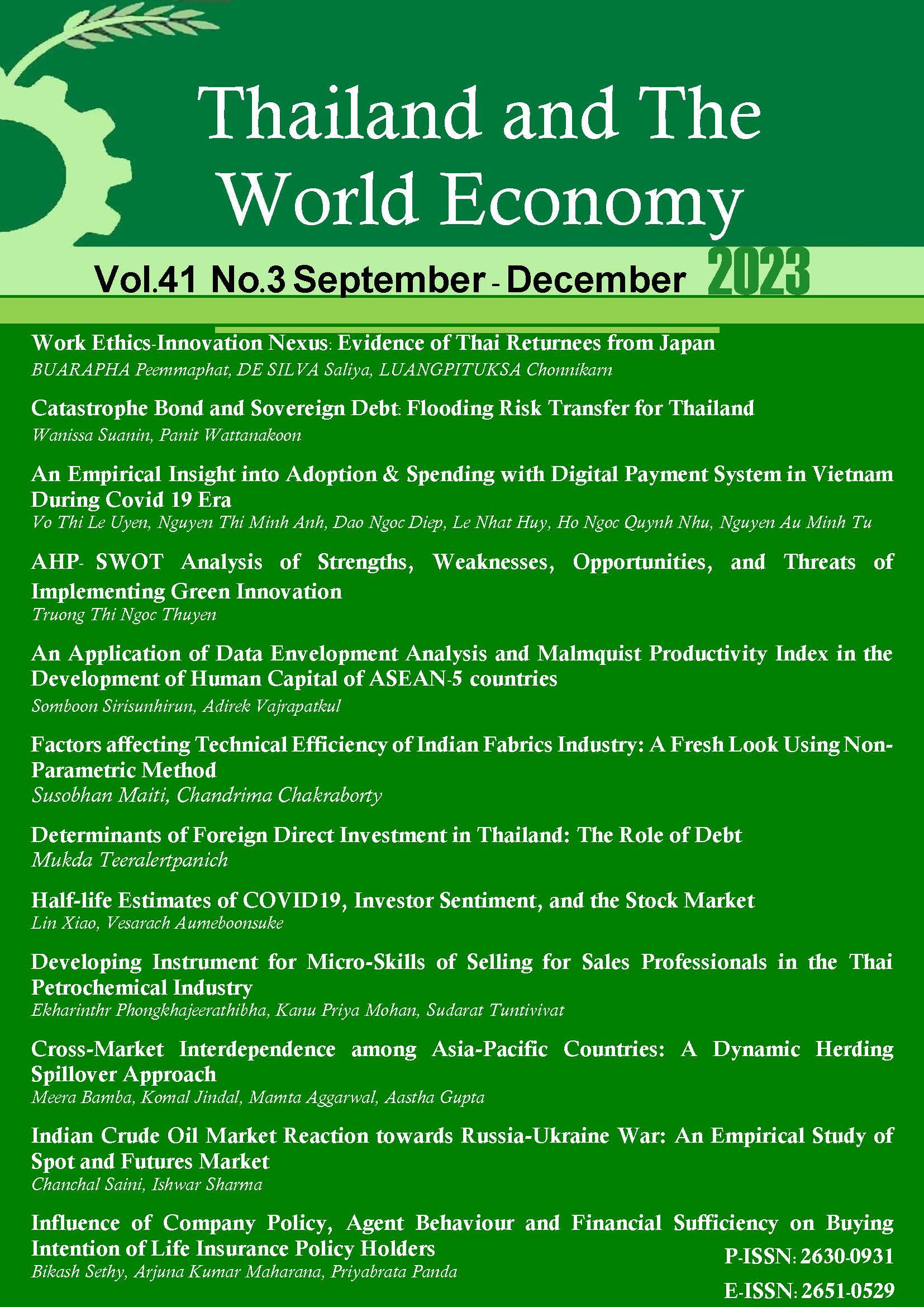An Application of Data Envelopment Analysis and Malmquist Productivity Index in the Development of Human Capital of ASEAN-5 countries
Keywords:
Human capital, Data Envelopment Analysis, Malmquist Productivity Index, ASEAN-5 countriesAbstract
This work highlights the support of some indicators, which are assumed to be resources, namely mobile usage, internet usage, private credit, government education expenditure, and the export of high-technology products, for human capital development. To investigate the efficiency and productivity of creating human capital, the methods of Data Envelopment Analysis (DEA) and the Malmquist Productivity Index (MPI) are applied to the 2017 data, 2018 data, and 2020 data of the selected ASEAN-5 countries, namely Indonesia, the Philippines, Vietnam, Thailand, and Malaysia. It is discovered that, in a constant return to scale, Thailand and Malaysia nearly reach full technical efficiency in developing human capital, and the rest are fully efficient. When measured in terms of variable return to scale, only Thailand is inefficient and is in the stage of decreasing return to scale. The comparison between 2018 and 2020 shows that human capital creation productivity in 2020 in Vietnam, Thailand, and Malaysia improved compared to 2018 as a result of technological improvement. However, they are still less than Indonesia, the Philippines, and the target optimal efficiency level. Therefore, the recommendations are that the governments of Thailand and Malaysia should make more effort to utilize their inputs to support human capital development.
References
Adewumi, S. B., & Enebe, N. B. (2019). Government educational expenditure and human capital development in west african countries. International Journal of Research and Innovation in Social Science (IJRISS),V. 3(6).546–556.
Ahmed, S., Hasan, M. Z., MacLennan, M., Dorin, F., Ahmed, M. W., Hasan, M. M., Hasan, S. M., Islam, M. T., & Khan, J. A. M. (2019). Measuring the efficiency of health systems in Asia: A data envelopment analysis. BMJ Open, 9(3), 1–12.
Asongu, S. A., Boateng, A., & Akamavi, R. K. (2016). Mobile phone innovation and inclusive human development: Evidence from Sub-Saharan Africa. SSRN Electronic Journal, AGDI Working Paper No. WP/16/027, 1–37.
Chakrabarti, R., Gorton, N., & Lovenheim, M. F. (2020). State investment in higher education: effects on human capital formation, student debt, and long-term financial outcomes of students. Federal Reserve Bank of New York Staff Reports No. 941, 1–86. Retrieved from https://www.newyorkfed.org/research/staff_reports/sr941.
Charnes, A., Cooper, W. W., & Rhodes, E. (1978). Measuring the efficiency of decision making units. European Journal of Operational Research, 2(6), 429-444. https://doi.org/https://doi.org/10.1016/0377-2217(78)90138-8
Coelli, T., Rao, D. S. P., & Battese, G. E. (1998). An introduction to efficiency and productivity analysis. Springer New York, NY. https://doi.org/10.1007/978-1-4615-5493-6
David, P. A. (2001). Knowledge, capabilities and human capital formation in economic growth. New Zealand Government, The Treasury, Wellington, New Zealand Treasury Working Paper No. 01/13, 1–155. Retrieved from https://www.treasury.govt.nz/sites/default/files/2007-10/twp01-13.pdf.
Djunaedi, A. Z. (2021). Digitalization impact on growth & human capital: indonesia broadband plan case study. Review of Business, Accounting & Finance, 1(3), 299–309.
Ejemeyovwi, J. O., Osabuohien, E. S., Johnson, O. D., & Bowale, E. I. K. (2019). Internet usage, innovation and human development nexus in Africa: The case of ECOWAS. Journal of Economic Structures, 8(1), 1–16.
Fan, Q., Goetz, S. J., & Liang, J. (2016). The interactive effects of human capital and quality of life on economic growth. Applied Economics, 48(53), 5186–5200.
Ferraz, D., Moralles, H. F., Campoli, J. S., Oliveira, F. C. R. de, & Rebelatto, D. A. do N. (2018). Economic complexity and human development: DEA performance measurement in Asia and Latin America. Gestão & Produção, 25(4), 839–853.
Kiliç, C., & Özcan, B. (2018). The impact of financial development on human capital: evidence from emerging market economies. Journal name – italicised, 8(1), 258–267.
Levin, A., & Raut, L. K. (1997). Complementarities between exports and human capital in economic growth: evidence from the semi‐industrialized countries. Economic Development and Cultural Change, 46(1), 155–174.
Mohsen, M., Samaneh, S., & Abbas Rezazadeh, K. (2017). Determinants of high-tech export in developing countries based on Bayesian model averaging. Preliminary Communication, 35(1), 199–215.
Patel, G., & Annapoorna, M. S. (2019). Public education expenditure and its impact on human resource development in india: An empirical analysis. South Asian Journal of Human Resources Management, 6(1), 97–109.
Ross, L. (2021). Finance, growth, and inequality. IMF Working Paper No. WP/21/164, 1–80. Retrieved from https://www.imf.org/en/Publications/WP/Issues/2021/06/11
/Finance-Growth-and-Inequality-460698.
Saroj, S., Singh, P., & Shastri, R. K. (2022). Human capital formation through virtual education: current practices and future opportunities. Journal of Positive School Psychology, 6(4), 7033–7042.
Shailender, S., Muhammad, M. B., Nishant, K., & Hawati, J. (2021). Application of DEA‐based malmquist productivity index on health care system efficiency of ASEAN Countries. International Journal of Health Planning and Management., Volume – italicised(Issue or number),1–15.
Sheykhi, M. T. (2021). Human capital vs. quality of life: a sociological appraisal. Studies in Social Science Research, 3(1), 7–15.
Sima, V., Gheorghe, I. G., Subić, J., & Nancu, D. (2020). Influences of the industry 4.0 revolution on the human capital development and consumer behavior: A systematic review. Sustainability, 12(10), 1–28.
Smith, M. L., Spence, R., & Rashid, A. T. (2011). Mobile phones and expanding human capabilities. Information Technologies, 7(3), 77–88.
Son, H. H. (2010). Human capital development. ADB Economics Working Paper Series No. 225, 1–36. Retrieved from https://www.adb.org/publications/human-capital-development.
Tebaldi, E. (2011). The determinants of high-technology exports: a panel data analysis. Atlantic Economic Journal, 39(4), 343–353.
Wahyudi, S. T., & Azizah, A. (2018). A comparative study of banking efficiency in Asean-5: The data envelopment analysis (dea) approach. Journal of Indonesian Economy and Business, 33(2), 168–186.
Wang, C.-N., Nguyen, H.-P., & Chang, C.-W. (2021). Environmental efficiency evaluation in the top asian economies: An application of DEA. Mathematics, 9(8), 1–19.
Zrelli, H., Alsharif, A. H., & Tlili, I. (2020). Malmquist indexes of productivity change in Tunisian manufacturing industries. Sustainability, 12(4), 1–28.
Downloads
Published
How to Cite
Issue
Section
License
Copyright (c) 2023 Thailand and The World Economy

This work is licensed under a Creative Commons Attribution-NonCommercial-NoDerivatives 4.0 International License.










